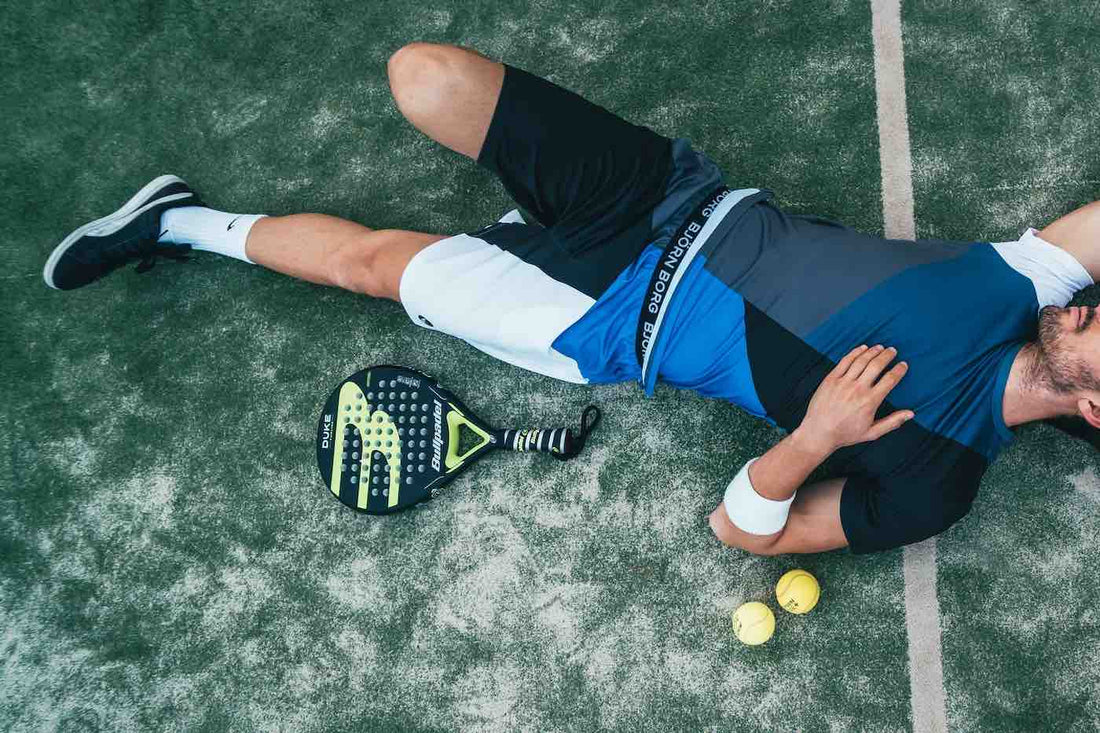
How to prevent padel injuries?
Share
This sport often requires an overload of joints, muscles and tendons, which can lead to problems such as epicondylitis, also known as “tennis elbow”, as well as other injuries to the wrist, hand, knees and spine.
Since the most common injuries are those caused by overload, it is important to take some specific precautions in your training routines, in order to prevent injuries that could lead to more complicated situations.
Which areas of the body are most vulnerable?
There are several areas of the body that can be overloaded, especially if those who practice them are not in good physical shape. Let's look at the areas where injuries are most common:
Elbow
Epicondylitis, or “tennis elbow”, is the most common type of injury and the one that most often compromises a player’s training. It is an overload injury that results from the excessive and repeated use of a tendon in relation to its connection to the bone. In this particular case, the repeated hits of the ball on the racket cause an overload of the extensor muscles of the forearm, which can lead to inflammation of the tendon.
Fish
Synovitis and tenosynovitis (inflammation of the tissues or bones) are also very common injuries with the potential to cause Quervain's lesions at the level of the thumb, or even tenosynovitis of the fingers, a problem known as “ trigger finger” (finger that catches).
Shoulder
Shoulder injuries are mainly caused by weakness in the rotator cuff muscles. This muscular structure is responsible for the stability of the shoulder joint. Fatigue or lack of strength in this area leads to instability and, consequently, additional or excessive stress on the rotator cuff, which can subsequently lead to tissue injuries (tears, inflammation, dislocation, bursitis, etc.)
Knee
Knee injuries can also compromise the practice of Padel. These conditions are also the result of overloading and forced movements of the knees. The most common are Osgood-Schlater disease (calcification of the patellar tendon), as well as patellar tendinosis (inflammation) and cartilage diseases (meniscus tears, chondropathies, etc.)
Fractures
Fatigue is also responsible for many fractures, known as “ stress fractures” or fatigue fractures. The bones most commonly involved in these injuries are the tibia and fibula (malleoli in the ankles), as well as the foot (scaphoid/navicular and metatarsals) and wrist.There are also severe trauma injuries such as ankle sprains, ligament and cartilage sprains, which occur during training.
How to prevent injuries when playing Padel?
Regardless of the intensity of the practice of this sport (amateur or professional), injury prevention is always the first objective that we must take into account, not only to achieve the best performance, but also to ensure that you do not have injuries that compromise the practice of the sport. Follow these 3 recommendations:
1- Before picking up the racket
Acute injuries often result from a lack of knowledge of the general safety procedures or rules for playing this sport. To this end, it is essential to start playing Padel with the support of an instructor or coach who can explain the correct movements to perform during the game.
In addition to this aspect, it is important to find out about the appropriate equipment (rackets and shoes), as well as the correct warm-up and cool-down movements and positions.
2- Neuromuscular training
Stretching muscles and tendons can be combined with muscle dexterity training that facilitates movement. These stretches and dexterity exercises literally extend from the fingertips to the major muscle groups. A regular, targeted program in this regard can help prevent numerous injuries, both to the upper and lower limbs.
3- Know the weak points
For Padel players who are more prone to certain types of injuries, we can use taping (neuromuscular bands or functional bandages) or orthoses (elastic socks, for example) to prevent or minimize risks during sports practice.
How to prevent the most common injuries?
Prevention of tendonitis of the forearm extensors at the elbow (epicondylitis), which in addition to being frequent can become chronic, should focus on a program centered on stretching the forearm, as well as studying the best technique for handling the racket with the instructor or coach.Shoulder injuries , particularly those of the rotator cuff, can be prevented by strengthening these muscles. Simple exercises are recommended, with the help of bands or elastic bands, and without excessive repetitions, as this can lead to the aggravation of the injury in question.
For wrist and finger overuse injuries, neuromuscular training and appropriate stretching, such as dexterity, strength and stretching exercises, are recommended. The PowerBall® is always a useful, practical and easy-to-use tool for this regular appointment.
In the prevention of fatigue fractures in Padel the advice is as previously mentioned: observe equipment and safety rules, as well as strengthen, stretch and maintain a progressive practice appropriate to the physical level of the practitioner.


